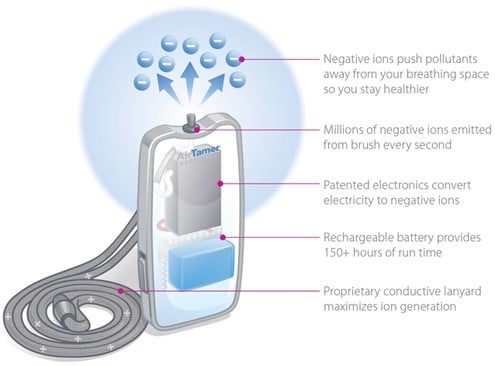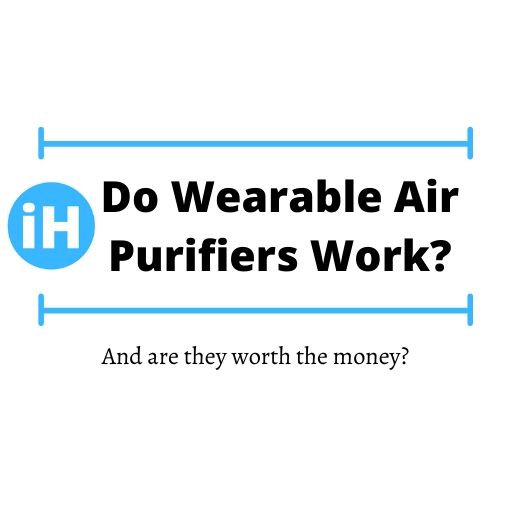The air quality of the air that we breathe has become increasingly important in the last few years. Consequently, people turn to all kinds of different air purifiers for a solution. One of these newer solutions, which I keep coming across more and more often, is wearable air purifiers. As the number of wearable air purifiers keeps increasing, the main question around them stays the same – do wearable air purifiers work? Since there are many different pieces of information scattered around the web, I thought it would be helpful to consolidate it all in one single post. Along with my personal experience, here is what I found.
So, do air wearable air purifiers work? Yes and no. Neck purifiers can not offer you complete protection against harmful air particles but can help reduce some of them. The problem lies within the very small size and inferior technology inside these devices. They mostly use negative ion technology for air cleaning, but can not produce a sufficient amount of negative ions to make them a viable, complete protection tool. They will work but do not expect miracles from them.
I have also prepared a more detailed answer below, so if you are interested in specifics – read on!
What Are Wearable Air Purifiers?
Wearable Air purifiers, sometimes called personal air purifiers, are a type of air purifiers that you put around your neck in order to reduce the chance of inhaling harmful particles and air pollutants. In theory, their purpose is pretty straightforward – you wear them around your neck to protect yourself against air pollutants and harmful particles, anywhere you go. So you can think of them as portable air cleaners around your neck. Now 95% of wearable air purifiers do not use filters but release negative ions in the air. Consequently, virtually all neck air purifiers are air ionizers, sometimes also called negative ion generators or simply ionic air purifiers.
Noiseless and filterless, they are made to effectively get rid of bacteria, dust, smoke, and allergens from the immediate air around you, as you are moving around. This reduces the chance of you inhaling these pollutants. Wearable air purifiers are the smallest and most portable type of air purifiers, which you can bring with you virtually anywhere and everywhere.
If you do some research on your own, you will see that many websites classify do not differentiate between wearable and personal air purifiers. Why you can mostly get away with this, I do recommend differentiating them to avoid any confusion. All wearable air purifiers are personal air purifiers, but not all personal air purifiers are wearable air purifiers. Some personal air purifiers you can take with you traveling, or to the office, but can not wear directly on your neck.
How Do Wearable Air Purifiers Work?
As I already touched on this in the previous part, wearable air purifiers are negative ion generators. This means that they release negative ions in the air, which then clean the air around you. For an easier representation, refer to the picture below.

Source: Air Tamer
As you can see, the process is pretty straightforward. An electronic component inside of the device converts electricity into negative ions, which come out of the device through a brush (or some other element of ionization) located on top of the device.
Negative ions are, as the name would suggest, negatively charged particles. Once they are in the air, they attach themselves to neutral or positive particles. Luckily for us, air pollutants and other harmful particles in the air happen to be positively charged! So just like magnets, negative ions interact with these pollutants. Once negative ions “connect” with positively charged particles, the combined weight becomes large enough for gravity to start doing its thing. In other words, gravity starts pulling down this newly formed mass of air pollutants, mixed with negative ions, to the ground. Why should you care if gravity starts to pull down air pollutants around you? Because you can not inhale them into your body, that’s why!
I have not found any wearable air purifier that would use HEPA filters or any other type of filter. As you might imagine, it would be very challenging to make the classic 3-stage filtration system (pre-filter, HEPA filter, carbon activated filter), that you find in standard home air purifiers, in such a small device. Not to mention how hard it would be to replace the filters.
Dangers Of Using Wearable Air Purifiers
Are wearable air purifiers safe? That is another common question that many people have in connection to this topic. Since virtually all wearable air purifiers are basically portable air ionizers, they also come with the same flaw – ozone production. If you were not already aware, most ionic air purifiers (air ionizers) produce ozone as a byproduct when creating negative ions. Now ozone is great, it protects us from harmful UV rays that come from our sun…but it does that from far away, way up in the atmosphere. Up close, however, ozone irritates our lungs and is harmful to our health. It negatively affects us in very small quantities already, but people with asthma, allergies, the elderly, and kids are that much more vulnerable.
You can now see the dilemma. On one hand, you are wearing a device that is supposed to remove even the smallest harmful particles from the air through the use of negative ions. But at the same time, it is releasing ozone into the air, practically right under your nose.
I have found some exceptions here, like AirTamer, which does not produce ozone. But the vast majority of wearable air purifiers do produce ozone, which is quite a big downside. So are wearable air purifiers safe? Yes, if they do not produce ozone as a byproduct.
Effectiveness
So if wearable air purifiers work, the next logical question is how effective are they? I did some research and could not find any direct scientific articles that would support (or deny) the effectiveness of wearable air purifiers. Obviously, you have manufacturer claims, which they make based on their own internal studies but these are mostly private and not just readily accessible to everyone.
I have been working in the air purifying industry for some years now. I have tried and tested many air ionizers and they do work. Not only do they work, but negative ions are the most effective air cleaning method. However, this claim comes with a big “if” – emission of negative ions. Air ionizers are the best air cleaners only if they have a high enough emission of negative ions. Anything below 7 million negative ions per second (ion emission) is, in my experience, not sufficient for optimal air cleaning. That is because there are SO many harmful particles in the air.
While negative ions can remove even the smallest pollutants, there have to be enough negative ions for effective air cleaning. One negative ion can attach itself to only one harmful particle and that is it. Sometimes 1 harmful particle even requires even 2 or 3 negative ions. So if you have a small number of negative ions – sure, they will clean all the harmful particles in the air, but only a part of that air.
The other issue that limits effectiveness is simply just moving around as you go about your day. But why is this an issue? Well air ionizer, just like all other air purifiers, needs time to clean the air. Typically, a powerful air ionizer needs around 3-4 hours to completely clean a room. But while you are moving or walking around you are constantly in contact with new air, meaning new harmful particles. There is just not enough time for the wearable ionizer to do its job effectively if you are constantly on the move.
Are wearable purifiers worth the money?
This is a tough one to correctly answer since we have a few variables here. In general, I would say that wearable air purifiers can be worth your money if you are looking to improve the quality of the air directly around you. The key word here is “improve” – you can not expect a fully 100% clean, in this case. This is mainly due to the limitation of negative ion emission that these devices can produce. I have seen wearable air purifiers that can produce up to 2 million negative ions. While his number seems high, it is still simply not enough.
Who would I recommend this to? If you move around a lot during the day (travel even) and are looking for something that will lower your chances of inhaling harmful particles, then you could give a wearable air purifier a go. The main thing here is to have reasonable expectations. Some protection is still better than no protection. This is NOT a device that will offer you complete protection from air pollutants. A model with no ozone product is also much better to choose from (even more so if you suffer from allergies). Generally, you will find them priced around $20-$40, which is not that high for what they can offer. Some protection is better than no protection.
Conclusion
Wearable air purifiers are interesting, yet somewhat limited air purifying devices. Do wearable air purifiers work? Yes, but only up to a point. They do clean the air around you and remove harmful particles, just not all of them. Most of them also release ozone, which you should avoid if possible. Do not expect them to perform miracles or be as effective as a regular home purifier and you will not be disappointed.
Lastly, If you are looking for a cheap air purifier for your home, then I would personally not recommend a wearable air purifier as your first choice -even if you are new to the air purifying world and just want something cheap to start out with. I have made a list of the 5 best cheap air purifiers under $50 for your home, as a better alternative. These are all still personal and portable air purifiers, but much more effective (however you can not wear them!). They are also budget-friendly and just a little bit more expensive than wearable air purifiers.
I hope this article helped you get a better understanding of this topic. In case of any questions, feel free to comment below.
How wearable air purifier works?
Wearable air purifiers emit thousands of ions in the air every minute that makes the air pure around your surroundings. A wearable air purifier works the best when you travel frequently
What is a wearable air purifier?
A wearable air purifier is a mobile air purifier that can you can wear on your body that comes in a form of a necklace for better mobility. And they are small in size.
Is a wearable air purifier safe?
Yes, a Wearable air purifier is completely safe. This makes the air around your surroundings completely safe to breathe.
